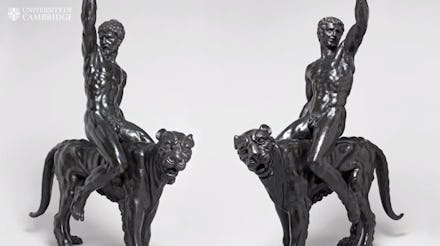These Statues of Nude Men Riding on Panthers Might Be Michelangelo's Lost Masterpieces

If you've ever ridden around on a panther, you might be just one degree of separation away from one of the greatest artists of all time.
Two bronze statues of muscular men riding panthers, most recently thought to be the work of an unknown 16th-century Roman sculptor, may actually be the creations of Michelangelo, the Italian painter, sculptor, architect and engineer of the High Renaissance. A team of experts at the University of Cambridge and Fitzwilliam Museum made the stunning pronouncement, arguing that they have compelling evidence to back up the groundbreaking discovery.
The claim still needs to be verified by other experts — the team plans on presenting the new evidence at a conference in July — but if true, the statues, titled "Nude bacchants riding panthers," would become the only known surviving Michelangelo bronzes in the world.
"We've done due diligence," Victoria Avery, a lead curator in the applied arts department at Fitzwilliam Museum, told the New York Times. "It's the right moment to present it to the wider world. And if there is a strong counter-case, then, fine, let it be heard. This is how scholarship moves on."
The evidence: "Last autumn Paul Joannides, emeritus professor of art history at the University of Cambridge, connected the work to a drawing by one of Michelangelo's apprentices," which was a copy of an earlier sketch by the master himself, according to The Daily Mail.
The drawing contains a depiction of a muscular young man riding a panther, and according to the museum, it was "drawn in the abrupt, forceful manner" that Michelangelo used in sculpture designs. "This suggests that Michelangelo was working up this very unusual theme for a work in three dimensions," the museum notes.
This discovery prompted an even deeper dive. The panther riders were compared to other works by Michelangelo and were found to be similar to his other creations dated between 1500 and 1510. A neutron imaging lab also revealed they had thick walls, a sign they were created during Michelangelo's time, when Italian bronzework was still in development, according to the New York Times.
As groundbreaking as a confirmation of the discovery would be, however, it isn't entirely out of the realm of possibility. The bronzes were originally attributed to Michelangelo in the 19th century, but because they are unsigned and lack documentation, the attribution was dismissed.
"The bronzes are exceptionally powerful and compelling works of art that deserve close-up study," Avery said. "We hope the public will come and examine them for themselves and engage with this ongoing debate."
h/t Public Radio International
Editor's Note: Feb. 13, 2015
Due to an attribution error in the editing process, an earlier version of this article failed to attribute information and language from The Daily Mail. The story has been updated to fully attribute The Daily Mail's language.